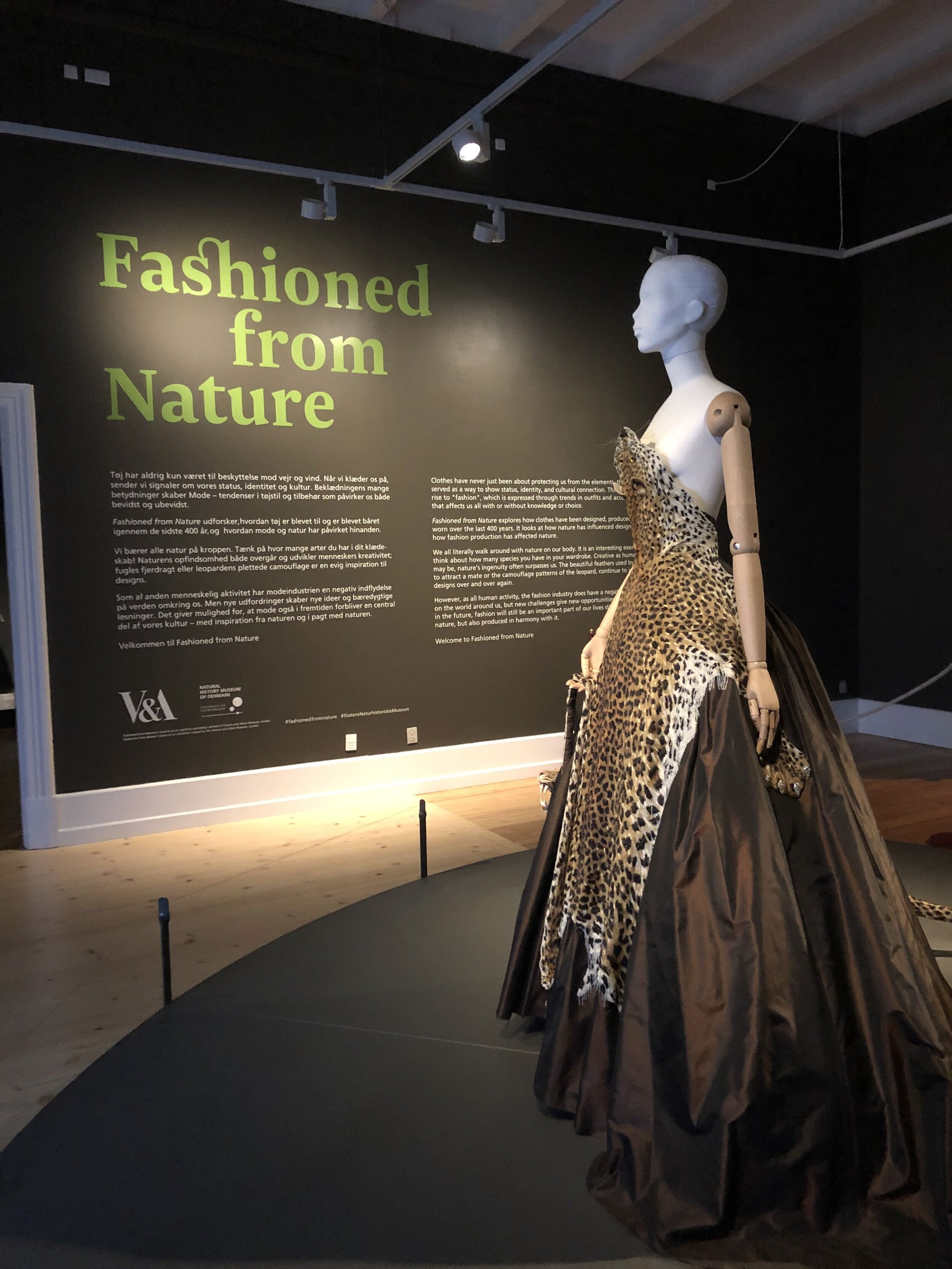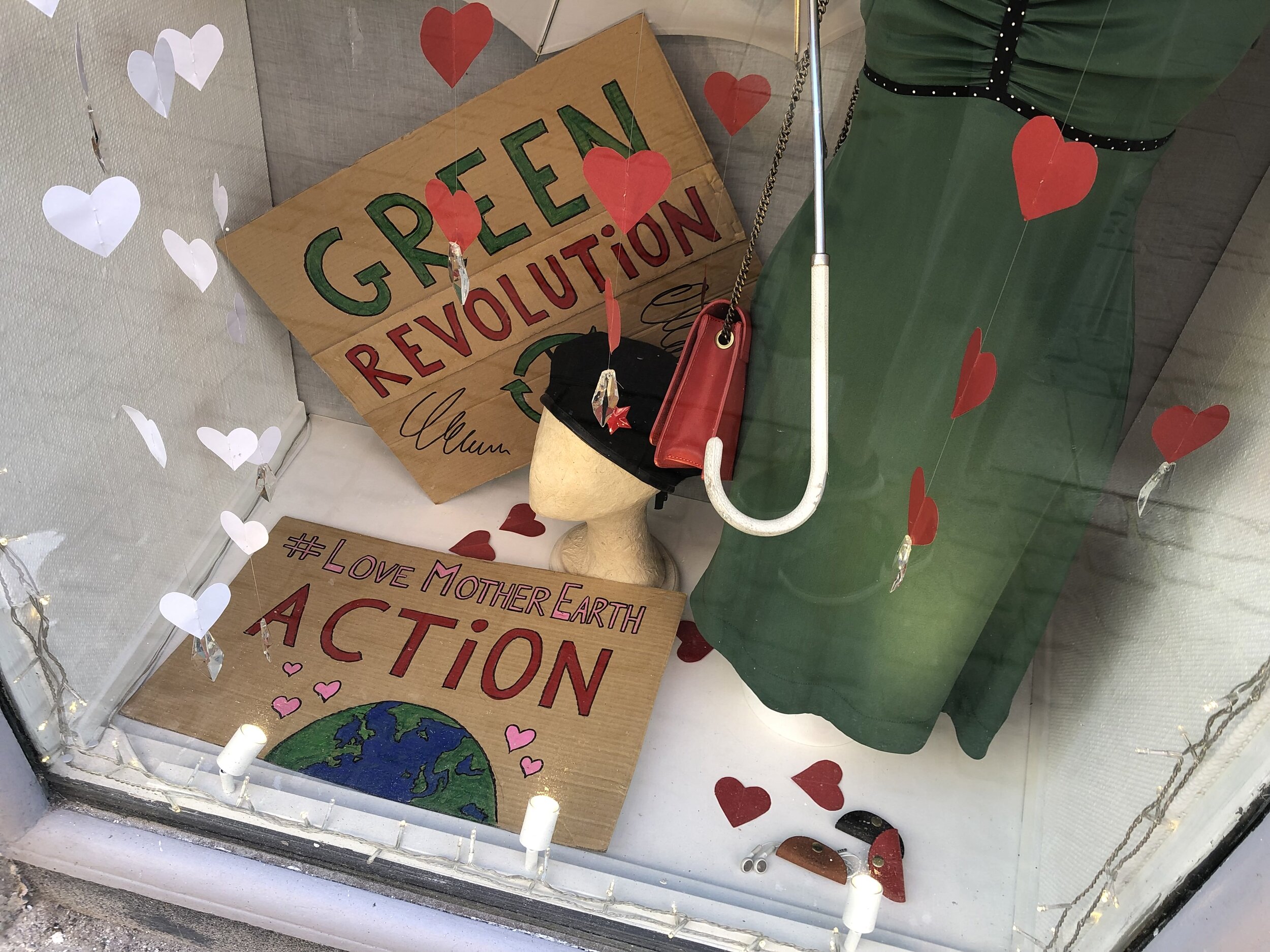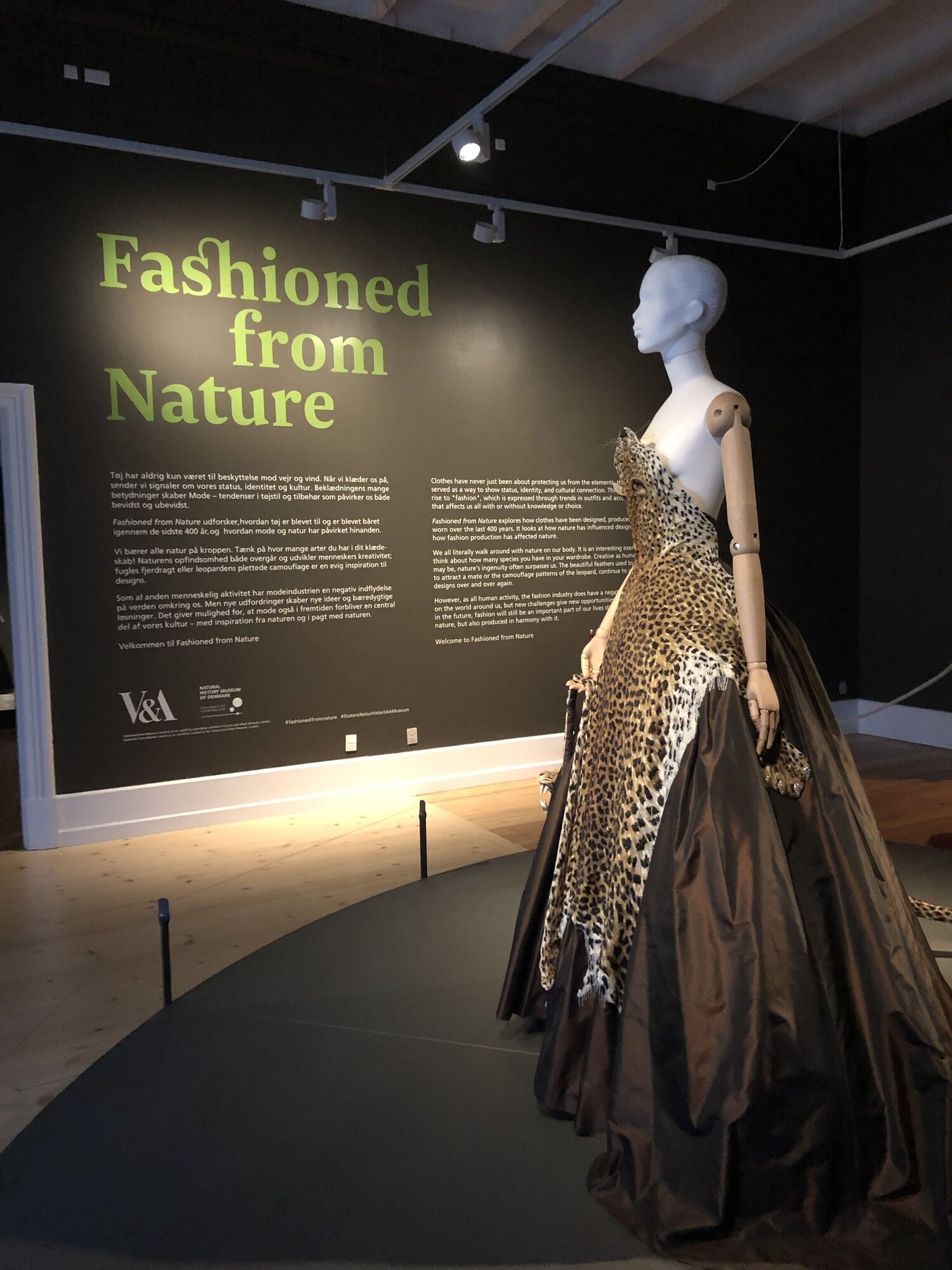Written by Erin Herock
So what is “sustainable fashion”?
Sustainable fashion focuses on ethical, low-carbon production all the way up to the distribution of it. It is also referred to as “slow fashion”. Essentially the supply chain is as clean, efficient, and equitable as possible. Patagonia is a commonly known, well-respected company that falls under this definition.
Some of the key components of sustainable clothing:
-
ethically sourced materials – low-impact on the environment in extraction of material
-
ethical labor – fair wages and conditions
-
made to last – or at least repairable
-
gives back to the environment (really stellar, but not “necessary”) – a sustainable business model that cares about our future, not just profits
Sounds great, right? Well there’s a few problems with this concept, along with the fashion industry as a whole.

The Fashioned from Nature exhibit I walked through in Copenhagen, Denmark explored the complex relationship between fashion and nature.
The Problems
Why is sustainable fashion is pushed now?
Fashion, as we know, relies upon trends. These are quickly evolving styles that consumers demand, but also what industry creates to make a lot of money. They push people to always have the latest styles, even if they won’t last a month. Companies that capitalize on this quickly changing wardrobe are known as fast fashion corporations. “Fast-fashion” has become a buzz-word that essentially means cheap clothing and cheap labor. This is the opposite of what sustainable fashion strives for. Several companies that come to mind are Zara, H&M, and Forever-21.

Is Sustainable Shopping Better?
I formulated this question through a really great conversation I had in Copenhagen, Denmark. I went to an ethical fashion store one morning called the Res Res (they had some cute stuff, but I was on a budget). The owner instantly knew I wasn’t from there, and we struck up a conversation about sustainable fashion and how the two words “sustainable” and “fashion” have an interesting relationship with one another.
My interpretation of these definitions is that sustainability refers to a project, item, or material lasting through time with as little impact on the environment. Fashion refers to trends that come and go fairly quickly, all in interest to remain in style.
So, the question to my title is “yes” in short, but is better good enough? When I talked to the sales associate working at the Res Res, he was even aware of the weirdness of sustainable fashion existing because sustainability should mean to stop buying things you don’t need. Most of the time you don’t need any more clothing. Also, with the plethora of second-hand clothing, buying new clothing seems even more wasteful, even if it is ethically and sustainably sourced.
There’s a problem with inclusion in sustainable fashion.
If you’ve ever visited a popular sustainable fashion website like Reformation, you will quickly realize how nothing will be under $60. Most tops range from $68-150. That is a LOT of money for one piece of clothing. So to expect everyone to be able to afford sustainable fashion is extremely unreasonable. Now before you get mad about the prices, understand there is a good reason for that price, and for people who can afford and are privileged enough to buy these pieces, they should. Workers are typically well paid, companies take caution in understanding and improving their carbon footprint, and overall the company is trying a little more than the fashion industry standard.
Another problem is with size and color inclusion. Often times, these companies are European-based that showcase extremely petite models and size-ranges that wouldn’t fit even the typical American. In addition, rarely women of color are modeled in these clothing pieces. The sustainable fashion industry needs to be more inclusive if they are to claim they are more equitable and ethical.
Be wary of green-washing and lack of transparency.
So a lot of companies these days know that environmentally conscious customers are looking for sustainable products and alternatives. This gives them a great excuse to slap the word “zero-waste” or “sustainable” onto literally anything. If they do not have a third-party verification like Fair Trade, 1% for the Planet, and other legitimate certifications I would be a little wary. But then again, there are problems with these certifications as well.
A rule of thumb is that if it seem too good to be true (in terms of price), then it probably is! A cheap shirt will not be able to pay workers fairly, I guarantee. Also, look for transparency. If you have a little bit of time, go on their website or email them. Ask them “who made this shirt?” If they are truly ethical, they will be able to provide you an answer and will be happy share their practices.
That $10 shirt has a greater hidden cost.
The people behind your garment.
In 2013, a clothing factory in Bangladesh collapsed, tragically killing 1,100 and injuring 2,500. This accident known as the Raza Plaza Disaster highlighted a huge problem with cheap labor in countries that have poor working conditions. Although some reforms have been made since this catastrophe, sweatshops still exist and this could still easily happen again. You can find similar stories and tragedies all over the world, in which women and child must work in unsafe conditions for an extremely low pay. In addition, the dyes and wastewater from these factories is extremely polluting, affecting local communities.

Donating isn’t the end of the clothing life-cycle.
Fast fashion clothing is notorious for falling apart in a matter of a few wears. So donate it? Not a chance. Donation centers do not put everything out on their floor because most of the time the clothing is unwearable due to quality issues Donating is important, but it shouldn’t be an excuse for your spending habits.
So, where does all of the clothing go?
Sometimes donated clothing is sold to third-party recyclers that make materials such as insulation out of the clothing. Recycling of clothing is difficult as textiles become weaker when undergoing the recycling process. However, a large percentage of donated clothing gets shoved into massive bales to be sold across the ocean to African countries. Local markets sell these clothing pieces, which often times there is way too much stock, and it has caused damage to indigenous markets and to the environment. It is providing some jobs, but is there a better solution? Read this article to learn more: What Really Happens When You Donate Your Clothes – And Why It’s Bad.
Solutions
-
Stop buying fast fashion. Fast fashion includes American Eagle, Urban Outfitters, and a lot of brands you may be surprised about. Now, yes, you can slip up from time to time, because it is impossible not to initially, but realize that brands mistreating their workers and the environment shouldn’t be given any more money.
-
When you want or “need” a new item, start saving up. For instance, maybe your sneakers just wore through in the toe and you no longer have “toe-protection”. Save up and find the best match between sustainability and price range. I find I don’t NEED anything, really. So if I feel like I will get a ton of use out of an item and it is made to last, I will save up to buy 1 item instead of 4.
-
Always look second-hand if you’re itching to get rid of that shopping urge. Go to your neighborhood thriftstore for local finds. Looking for something specific? Poshmark is also a great way to go and a great way to sell your clothing too!
-
Renting clothing has become so convenient! I currently have a rental subscription with Rent the Runway that allows me to have 4 pieces of clothing from the site at a time, and I get to swap a piece once a month. I just have to pay a monthly flat rate, and now I have access to a huge, revolving closet!
-
Do a clothing swap with friends. My friends and I yearly have collect all of our donation clothing and given each other free picks before it’s off to Goodwill. This is a fun way to see your pieces get a new life, while seeing them on the people you love!
-
Just don’t buy anything. Seriously. Take up sewing and modify your clothing. If a shirt fits poorly, tailor it to your body or if a dress is too short, make it into a top. There is already so much textile fabric in your closet, and by re-purposing and just re-wearing it, that can make a huge impact on your overall textile waste.

Being sustainable with fashion will always have its problems. But if you value the idea of fashion as a form of self-expression and want to support the workers that make beautiful, natural-fiber clothing, then go ahead and buy that $70 shirt. Sustainable fashion is about being conscious of our decisions in who we support.
There is a sustainable fashion conference virtually tomorrow: https://www.thesustainablefashionforum.com/, so feel free to join me to gain some insight on current sustainable fashion practices and goals.

